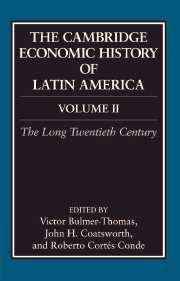Book contents
- Frontmatter
- Introduction
- Part I Cycles of Globalization
- 1 Globalization in Latin America before 1940
- 2 Foreign Capital Flows
- 3 The External Context
- 4 Globalization and the New Economic Model in Latin America
- Part II Onset of Modernization
- Part III Factor Endowments
- Part IV Sectoral Development and Equity
- Bibliographical Essays
- Index
- References
3 - The External Context
from Part I - Cycles of Globalization
Published online by Cambridge University Press: 28 March 2008
- Frontmatter
- Introduction
- Part I Cycles of Globalization
- 1 Globalization in Latin America before 1940
- 2 Foreign Capital Flows
- 3 The External Context
- 4 Globalization and the New Economic Model in Latin America
- Part II Onset of Modernization
- Part III Factor Endowments
- Part IV Sectoral Development and Equity
- Bibliographical Essays
- Index
- References
Summary
This chapter covers the time span between the great debt crises that began in 1928, when the Wall Street boom and the United States federal contractionary monetary policy started to crowd out new loans to Latin America, and 1982, when the Mexican debt crisis brought an end to the second cycle of voluntary international lending to Latin America that had started about fifteen years before. Between these major balance of payments crises, what happened in Latin America was strongly influenced by events in the world economy, but there was also a long-term trend making these economies much less outward-looking than they had been before the end of the 1920s, and furthermore, before 1914.
Fast recovery from the depression of 1928–33 followed the upturn in the developed economies after 1933. It was interrupted by the recession of 1937 in the United States and then by the effects of the Second World War on the progressive contraction of export markets until 1942. Good export performance and import compression in the remaining war years paved the way for a repayment of old foreign debt. But after the initial postwar period, most of Latin America faced the constraints imposed by the dollar shortage as reserves in dollars were restricted and import prices rocketed. European exports were badly affected by reconstruction demand and the United States was by far the major supplier of imports, even if restricted by the pressures of domestic demand. However, a boom in Latin American export prices in the late 1940s as well as during the Korean War (1950–4), eased the impact of the dollar shortage.
- Type
- Chapter
- Information
- The Cambridge Economic History of Latin America , pp. 101 - 134Publisher: Cambridge University PressPrint publication year: 2006
References
- 5
- Cited by



